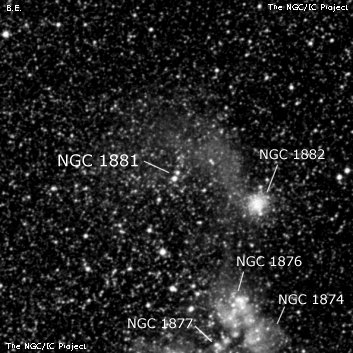
Although there is dim nebulosity generally north and west of the double, John Herschel's description and sketch refers to an asterism of 5-6 faint stars 2.5' following the pair of stars. Modern sources are incorrect in identifying NGC 1881 with the pair of mag 12 stars.
John Herschel discovered NGC 1881 = h2810 on 17 Jan 1838 and recorded "vF; follows a double star. An outlier of the arc-formed nebula and cluster [N1874/76/77]. Laid down in drawing Jan. 17, 1838, whence also its place. See Plate III. fig. 6." There are only a handful of faint stars near JH's position. See Corwin's notes and my visual description.
600/800mm - 24" (4/5/08 - Magellan Observatory, Australia): a long, curving chain of stars (part of stellar association LH 35) extends to the northeast of the NGC 1874/76/77 HII complex and ends at an easy pair of mag 12 stars (12" separation) located about 2.5' NE of the globular NGC 1872. At 260x, faint haze or unresolved stars, ~1' in diameter, encompasses this pair of stars.
Notes by Steve Gottlieb